Tourism and Media (1362) Report: Media Perceptions of Cyprus
VerifiedAdded on 2023/04/23
|9
|2718
|101
Report
AI Summary
This report provides a comprehensive analysis of how Limassol and Nicosia, two key destinations in Cyprus, are portrayed in the media, focusing on tourism perspectives. The report utilizes a media perception toolkit to examine a tourism development board website for Limassol and a travel blog dedicated to Nicosia. The analysis includes detailed assessments of each media source, evaluating their purpose, target market, tone of information, and the perceptions they create. The report also applies relevant media theories, specifically medium theory for the Limassol website and media richness theory for the Nicosia blog. The conclusion compares and contrasts the media images of both destinations, highlighting their cultural and historical significance, and how they are presented to potential tourists, thereby offering insights into the effectiveness of their respective media strategies in promoting tourism.
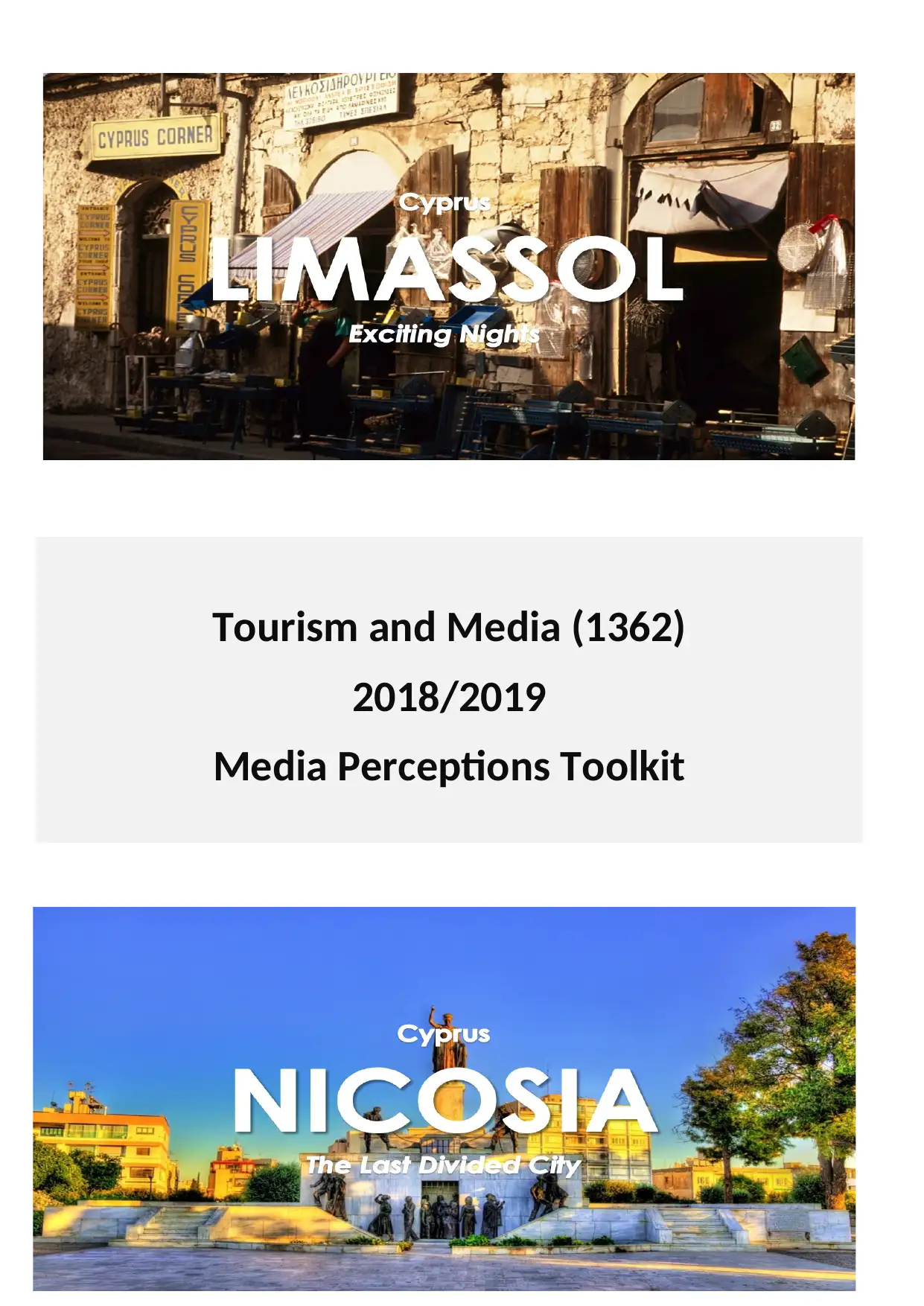
Tourism and Media (1362)
2018/2019
Media Perceptions Toolkit
2018/2019
Media Perceptions Toolkit
Paraphrase This Document
Need a fresh take? Get an instant paraphrase of this document with our AI Paraphraser
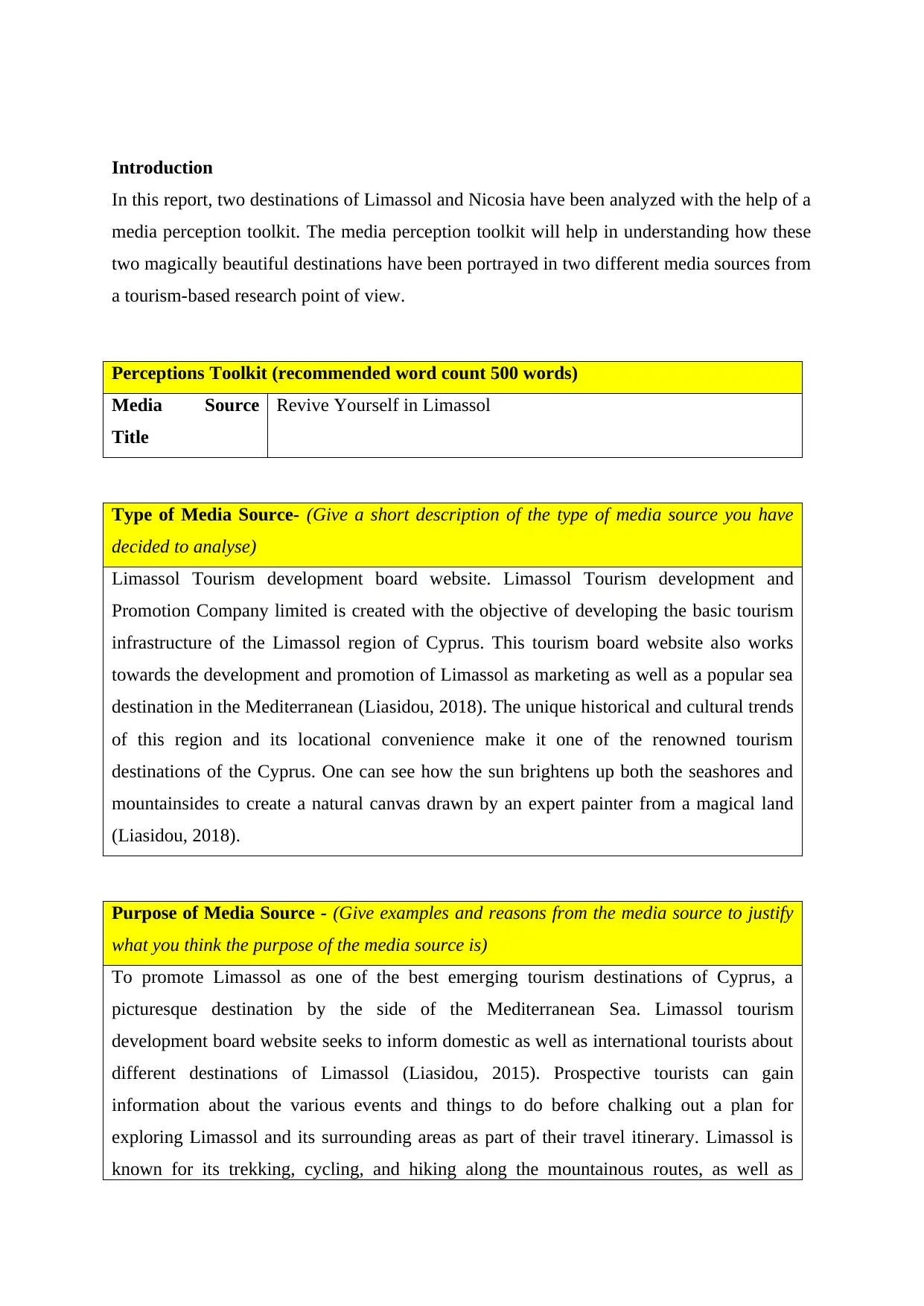
Introduction
In this report, two destinations of Limassol and Nicosia have been analyzed with the help of a
media perception toolkit. The media perception toolkit will help in understanding how these
two magically beautiful destinations have been portrayed in two different media sources from
a tourism-based research point of view.
Perceptions Toolkit (recommended word count 500 words)
Media Source
Title
Revive Yourself in Limassol
Type of Media Source- (Give a short description of the type of media source you have
decided to analyse)
Limassol Tourism development board website. Limassol Tourism development and
Promotion Company limited is created with the objective of developing the basic tourism
infrastructure of the Limassol region of Cyprus. This tourism board website also works
towards the development and promotion of Limassol as marketing as well as a popular sea
destination in the Mediterranean (Liasidou, 2018). The unique historical and cultural trends
of this region and its locational convenience make it one of the renowned tourism
destinations of the Cyprus. One can see how the sun brightens up both the seashores and
mountainsides to create a natural canvas drawn by an expert painter from a magical land
(Liasidou, 2018).
Purpose of Media Source - (Give examples and reasons from the media source to justify
what you think the purpose of the media source is)
To promote Limassol as one of the best emerging tourism destinations of Cyprus, a
picturesque destination by the side of the Mediterranean Sea. Limassol tourism
development board website seeks to inform domestic as well as international tourists about
different destinations of Limassol (Liasidou, 2015). Prospective tourists can gain
information about the various events and things to do before chalking out a plan for
exploring Limassol and its surrounding areas as part of their travel itinerary. Limassol is
known for its trekking, cycling, and hiking along the mountainous routes, as well as
In this report, two destinations of Limassol and Nicosia have been analyzed with the help of a
media perception toolkit. The media perception toolkit will help in understanding how these
two magically beautiful destinations have been portrayed in two different media sources from
a tourism-based research point of view.
Perceptions Toolkit (recommended word count 500 words)
Media Source
Title
Revive Yourself in Limassol
Type of Media Source- (Give a short description of the type of media source you have
decided to analyse)
Limassol Tourism development board website. Limassol Tourism development and
Promotion Company limited is created with the objective of developing the basic tourism
infrastructure of the Limassol region of Cyprus. This tourism board website also works
towards the development and promotion of Limassol as marketing as well as a popular sea
destination in the Mediterranean (Liasidou, 2018). The unique historical and cultural trends
of this region and its locational convenience make it one of the renowned tourism
destinations of the Cyprus. One can see how the sun brightens up both the seashores and
mountainsides to create a natural canvas drawn by an expert painter from a magical land
(Liasidou, 2018).
Purpose of Media Source - (Give examples and reasons from the media source to justify
what you think the purpose of the media source is)
To promote Limassol as one of the best emerging tourism destinations of Cyprus, a
picturesque destination by the side of the Mediterranean Sea. Limassol tourism
development board website seeks to inform domestic as well as international tourists about
different destinations of Limassol (Liasidou, 2015). Prospective tourists can gain
information about the various events and things to do before chalking out a plan for
exploring Limassol and its surrounding areas as part of their travel itinerary. Limassol is
known for its trekking, cycling, and hiking along the mountainous routes, as well as

gastronomic and shopping delights. This website aims to portray the city of Limassol as
one of the upcoming destinations, which has the potential to achieve much in terms of
tourism revenue (Liasidou, 2015).
Intended Target Market- (Give examples and reasons from the media source to justify
what you think the intended target market is)
The intended target market or target audiences are preferably people who want to explore
offbeat destination amongst the already popular one. Limassol is a city, which offers a
combination of both modernistic as well as ancient culture and architecture (Zopiatis et al.,
2016). It is city for the history-buffs as well as people who want to explore and enjoy a
nightlife that is full of glamour and entertainment. Wildlife and adventure enthusiasts can
have a gala time with jeep safaris and various kinds of water and air sports respectively. In
short, this is a city for everyone who wants to get everything in a single place (Zopiatis et
al., 2016).
Tone of Information Used- (Give examples and reasons from the media source to justify
what you think the tone of the media source is)
The tone of information used here is promotional and encouraging. Domestic as well as
international tourists can also have a look at the plethora of information available on the
website of the Limassol tourism development board (Theocharous et al., 2018). For
example- archaeology, art and culture, galleries, and libraries each have a dedicated page
of their own on this website with phone numbers and address of the places stated clearly.
The website is very responsive with a click taking just a few seconds to take one to the
desired information page (Theocharous et al., 2018).
Perception created by source- (Give examples and reasons from the media source to
explain the perception created)
According to my opinion, the perception created by the concerned media source, which is
the website, is positive and attractive. The beautiful digital images as well as crisp, brief
one of the upcoming destinations, which has the potential to achieve much in terms of
tourism revenue (Liasidou, 2015).
Intended Target Market- (Give examples and reasons from the media source to justify
what you think the intended target market is)
The intended target market or target audiences are preferably people who want to explore
offbeat destination amongst the already popular one. Limassol is a city, which offers a
combination of both modernistic as well as ancient culture and architecture (Zopiatis et al.,
2016). It is city for the history-buffs as well as people who want to explore and enjoy a
nightlife that is full of glamour and entertainment. Wildlife and adventure enthusiasts can
have a gala time with jeep safaris and various kinds of water and air sports respectively. In
short, this is a city for everyone who wants to get everything in a single place (Zopiatis et
al., 2016).
Tone of Information Used- (Give examples and reasons from the media source to justify
what you think the tone of the media source is)
The tone of information used here is promotional and encouraging. Domestic as well as
international tourists can also have a look at the plethora of information available on the
website of the Limassol tourism development board (Theocharous et al., 2018). For
example- archaeology, art and culture, galleries, and libraries each have a dedicated page
of their own on this website with phone numbers and address of the places stated clearly.
The website is very responsive with a click taking just a few seconds to take one to the
desired information page (Theocharous et al., 2018).
Perception created by source- (Give examples and reasons from the media source to
explain the perception created)
According to my opinion, the perception created by the concerned media source, which is
the website, is positive and attractive. The beautiful digital images as well as crisp, brief
⊘ This is a preview!⊘
Do you want full access?
Subscribe today to unlock all pages.

Trusted by 1+ million students worldwide
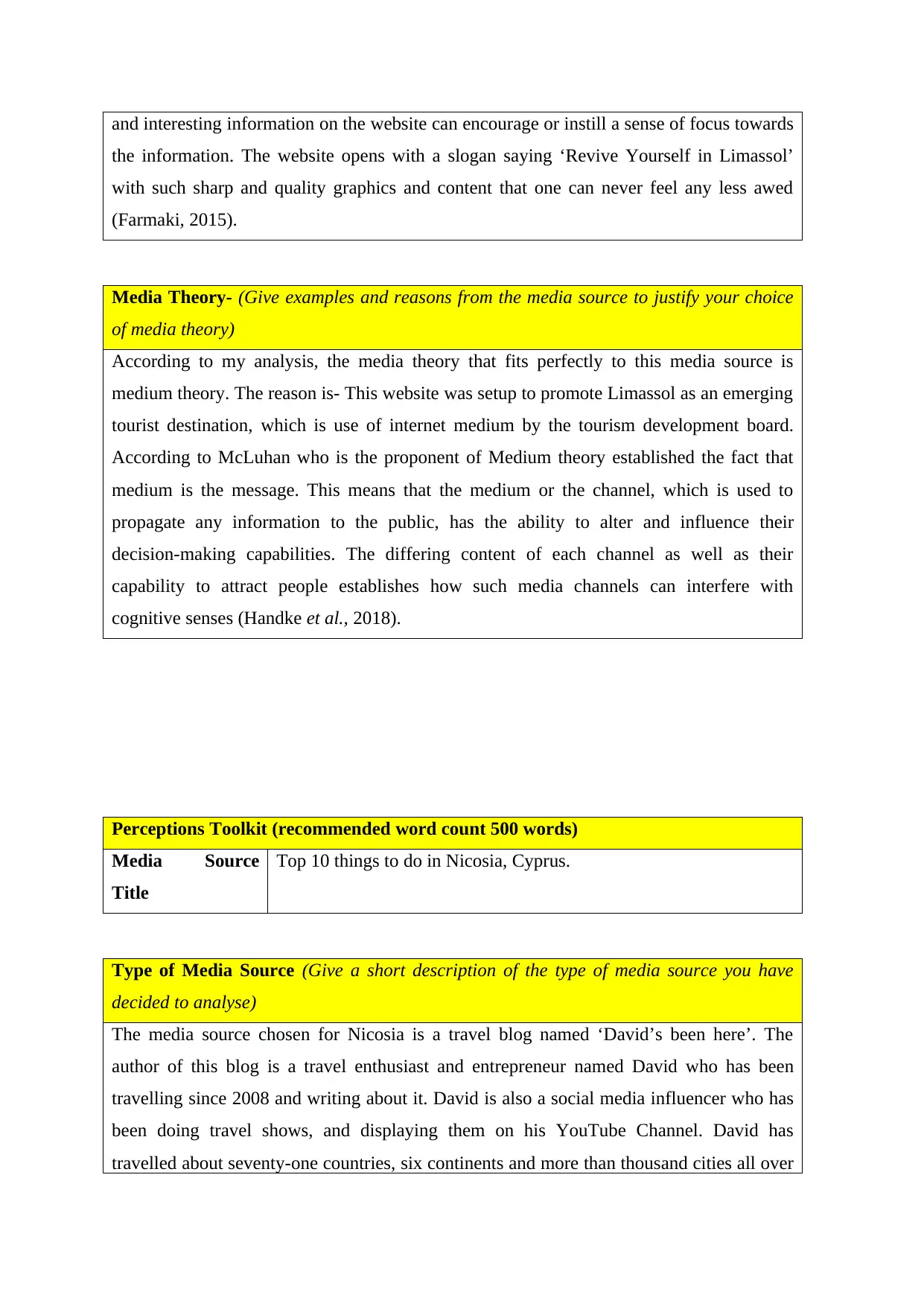
and interesting information on the website can encourage or instill a sense of focus towards
the information. The website opens with a slogan saying ‘Revive Yourself in Limassol’
with such sharp and quality graphics and content that one can never feel any less awed
(Farmaki, 2015).
Media Theory- (Give examples and reasons from the media source to justify your choice
of media theory)
According to my analysis, the media theory that fits perfectly to this media source is
medium theory. The reason is- This website was setup to promote Limassol as an emerging
tourist destination, which is use of internet medium by the tourism development board.
According to McLuhan who is the proponent of Medium theory established the fact that
medium is the message. This means that the medium or the channel, which is used to
propagate any information to the public, has the ability to alter and influence their
decision-making capabilities. The differing content of each channel as well as their
capability to attract people establishes how such media channels can interfere with
cognitive senses (Handke et al., 2018).
Perceptions Toolkit (recommended word count 500 words)
Media Source
Title
Top 10 things to do in Nicosia, Cyprus.
Type of Media Source (Give a short description of the type of media source you have
decided to analyse)
The media source chosen for Nicosia is a travel blog named ‘David’s been here’. The
author of this blog is a travel enthusiast and entrepreneur named David who has been
travelling since 2008 and writing about it. David is also a social media influencer who has
been doing travel shows, and displaying them on his YouTube Channel. David has
travelled about seventy-one countries, six continents and more than thousand cities all over
the information. The website opens with a slogan saying ‘Revive Yourself in Limassol’
with such sharp and quality graphics and content that one can never feel any less awed
(Farmaki, 2015).
Media Theory- (Give examples and reasons from the media source to justify your choice
of media theory)
According to my analysis, the media theory that fits perfectly to this media source is
medium theory. The reason is- This website was setup to promote Limassol as an emerging
tourist destination, which is use of internet medium by the tourism development board.
According to McLuhan who is the proponent of Medium theory established the fact that
medium is the message. This means that the medium or the channel, which is used to
propagate any information to the public, has the ability to alter and influence their
decision-making capabilities. The differing content of each channel as well as their
capability to attract people establishes how such media channels can interfere with
cognitive senses (Handke et al., 2018).
Perceptions Toolkit (recommended word count 500 words)
Media Source
Title
Top 10 things to do in Nicosia, Cyprus.
Type of Media Source (Give a short description of the type of media source you have
decided to analyse)
The media source chosen for Nicosia is a travel blog named ‘David’s been here’. The
author of this blog is a travel enthusiast and entrepreneur named David who has been
travelling since 2008 and writing about it. David is also a social media influencer who has
been doing travel shows, and displaying them on his YouTube Channel. David has
travelled about seventy-one countries, six continents and more than thousand cities all over
Paraphrase This Document
Need a fresh take? Get an instant paraphrase of this document with our AI Paraphraser
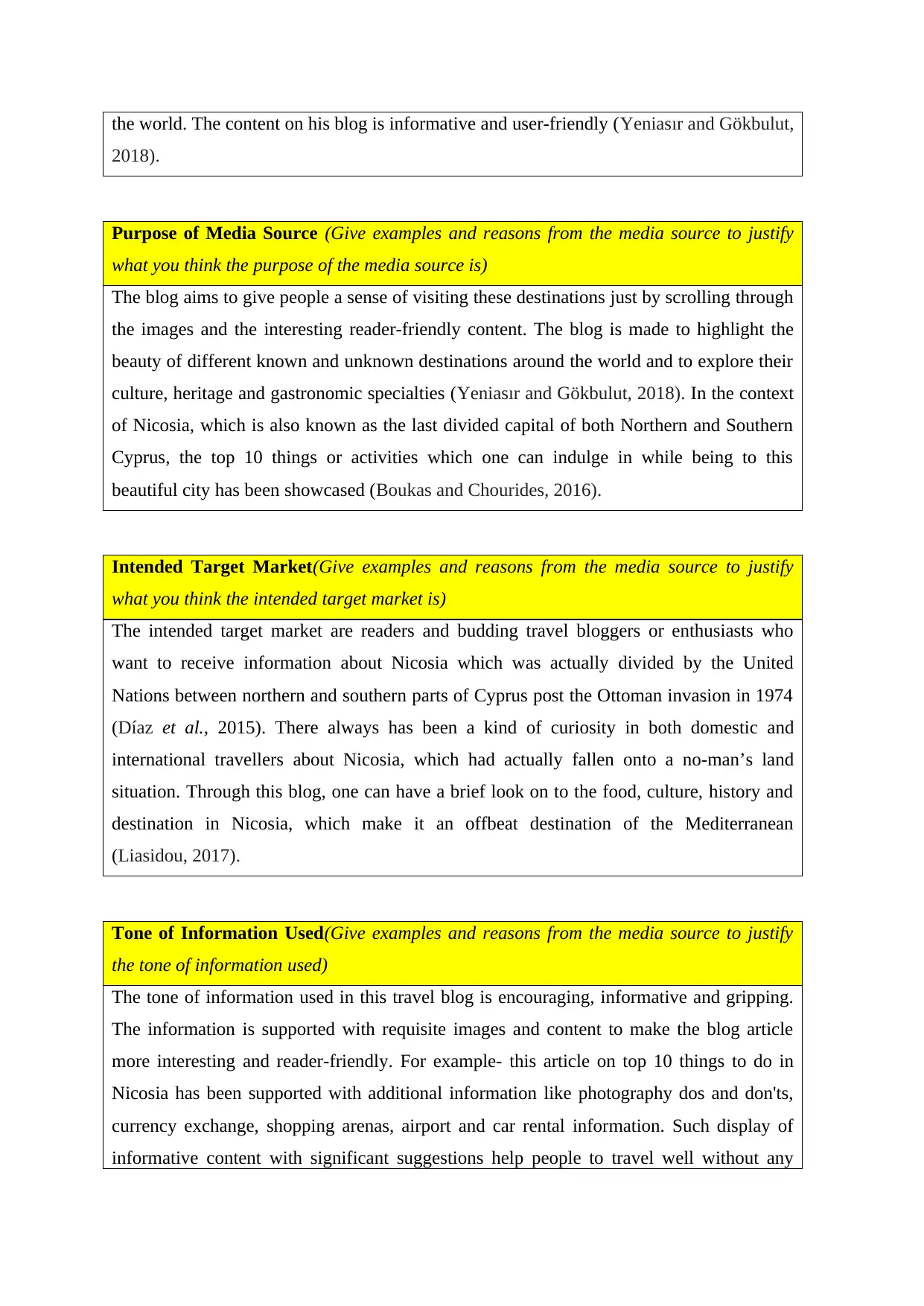
the world. The content on his blog is informative and user-friendly (Yeniasır and Gökbulut,
2018).
Purpose of Media Source (Give examples and reasons from the media source to justify
what you think the purpose of the media source is)
The blog aims to give people a sense of visiting these destinations just by scrolling through
the images and the interesting reader-friendly content. The blog is made to highlight the
beauty of different known and unknown destinations around the world and to explore their
culture, heritage and gastronomic specialties (Yeniasır and Gökbulut, 2018). In the context
of Nicosia, which is also known as the last divided capital of both Northern and Southern
Cyprus, the top 10 things or activities which one can indulge in while being to this
beautiful city has been showcased (Boukas and Chourides, 2016).
Intended Target Market(Give examples and reasons from the media source to justify
what you think the intended target market is)
The intended target market are readers and budding travel bloggers or enthusiasts who
want to receive information about Nicosia which was actually divided by the United
Nations between northern and southern parts of Cyprus post the Ottoman invasion in 1974
(Díaz et al., 2015). There always has been a kind of curiosity in both domestic and
international travellers about Nicosia, which had actually fallen onto a no-man’s land
situation. Through this blog, one can have a brief look on to the food, culture, history and
destination in Nicosia, which make it an offbeat destination of the Mediterranean
(Liasidou, 2017).
Tone of Information Used(Give examples and reasons from the media source to justify
the tone of information used)
The tone of information used in this travel blog is encouraging, informative and gripping.
The information is supported with requisite images and content to make the blog article
more interesting and reader-friendly. For example- this article on top 10 things to do in
Nicosia has been supported with additional information like photography dos and don'ts,
currency exchange, shopping arenas, airport and car rental information. Such display of
informative content with significant suggestions help people to travel well without any
2018).
Purpose of Media Source (Give examples and reasons from the media source to justify
what you think the purpose of the media source is)
The blog aims to give people a sense of visiting these destinations just by scrolling through
the images and the interesting reader-friendly content. The blog is made to highlight the
beauty of different known and unknown destinations around the world and to explore their
culture, heritage and gastronomic specialties (Yeniasır and Gökbulut, 2018). In the context
of Nicosia, which is also known as the last divided capital of both Northern and Southern
Cyprus, the top 10 things or activities which one can indulge in while being to this
beautiful city has been showcased (Boukas and Chourides, 2016).
Intended Target Market(Give examples and reasons from the media source to justify
what you think the intended target market is)
The intended target market are readers and budding travel bloggers or enthusiasts who
want to receive information about Nicosia which was actually divided by the United
Nations between northern and southern parts of Cyprus post the Ottoman invasion in 1974
(Díaz et al., 2015). There always has been a kind of curiosity in both domestic and
international travellers about Nicosia, which had actually fallen onto a no-man’s land
situation. Through this blog, one can have a brief look on to the food, culture, history and
destination in Nicosia, which make it an offbeat destination of the Mediterranean
(Liasidou, 2017).
Tone of Information Used(Give examples and reasons from the media source to justify
the tone of information used)
The tone of information used in this travel blog is encouraging, informative and gripping.
The information is supported with requisite images and content to make the blog article
more interesting and reader-friendly. For example- this article on top 10 things to do in
Nicosia has been supported with additional information like photography dos and don'ts,
currency exchange, shopping arenas, airport and car rental information. Such display of
informative content with significant suggestions help people to travel well without any
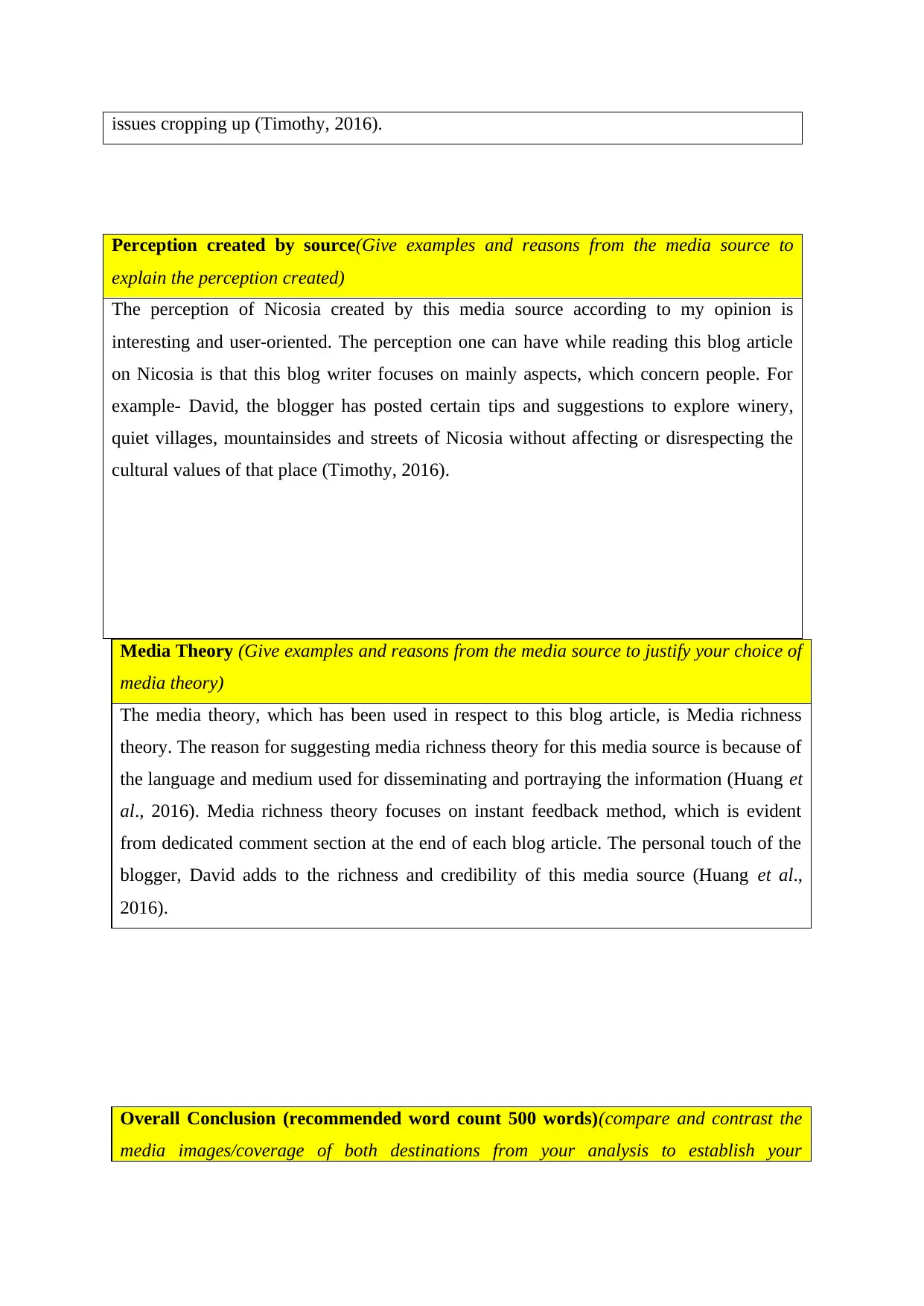
issues cropping up (Timothy, 2016).
Perception created by source(Give examples and reasons from the media source to
explain the perception created)
The perception of Nicosia created by this media source according to my opinion is
interesting and user-oriented. The perception one can have while reading this blog article
on Nicosia is that this blog writer focuses on mainly aspects, which concern people. For
example- David, the blogger has posted certain tips and suggestions to explore winery,
quiet villages, mountainsides and streets of Nicosia without affecting or disrespecting the
cultural values of that place (Timothy, 2016).
Media Theory (Give examples and reasons from the media source to justify your choice of
media theory)
The media theory, which has been used in respect to this blog article, is Media richness
theory. The reason for suggesting media richness theory for this media source is because of
the language and medium used for disseminating and portraying the information (Huang et
al., 2016). Media richness theory focuses on instant feedback method, which is evident
from dedicated comment section at the end of each blog article. The personal touch of the
blogger, David adds to the richness and credibility of this media source (Huang et al.,
2016).
Overall Conclusion (recommended word count 500 words)(compare and contrast the
media images/coverage of both destinations from your analysis to establish your
Perception created by source(Give examples and reasons from the media source to
explain the perception created)
The perception of Nicosia created by this media source according to my opinion is
interesting and user-oriented. The perception one can have while reading this blog article
on Nicosia is that this blog writer focuses on mainly aspects, which concern people. For
example- David, the blogger has posted certain tips and suggestions to explore winery,
quiet villages, mountainsides and streets of Nicosia without affecting or disrespecting the
cultural values of that place (Timothy, 2016).
Media Theory (Give examples and reasons from the media source to justify your choice of
media theory)
The media theory, which has been used in respect to this blog article, is Media richness
theory. The reason for suggesting media richness theory for this media source is because of
the language and medium used for disseminating and portraying the information (Huang et
al., 2016). Media richness theory focuses on instant feedback method, which is evident
from dedicated comment section at the end of each blog article. The personal touch of the
blogger, David adds to the richness and credibility of this media source (Huang et al.,
2016).
Overall Conclusion (recommended word count 500 words)(compare and contrast the
media images/coverage of both destinations from your analysis to establish your
⊘ This is a preview!⊘
Do you want full access?
Subscribe today to unlock all pages.

Trusted by 1+ million students worldwide
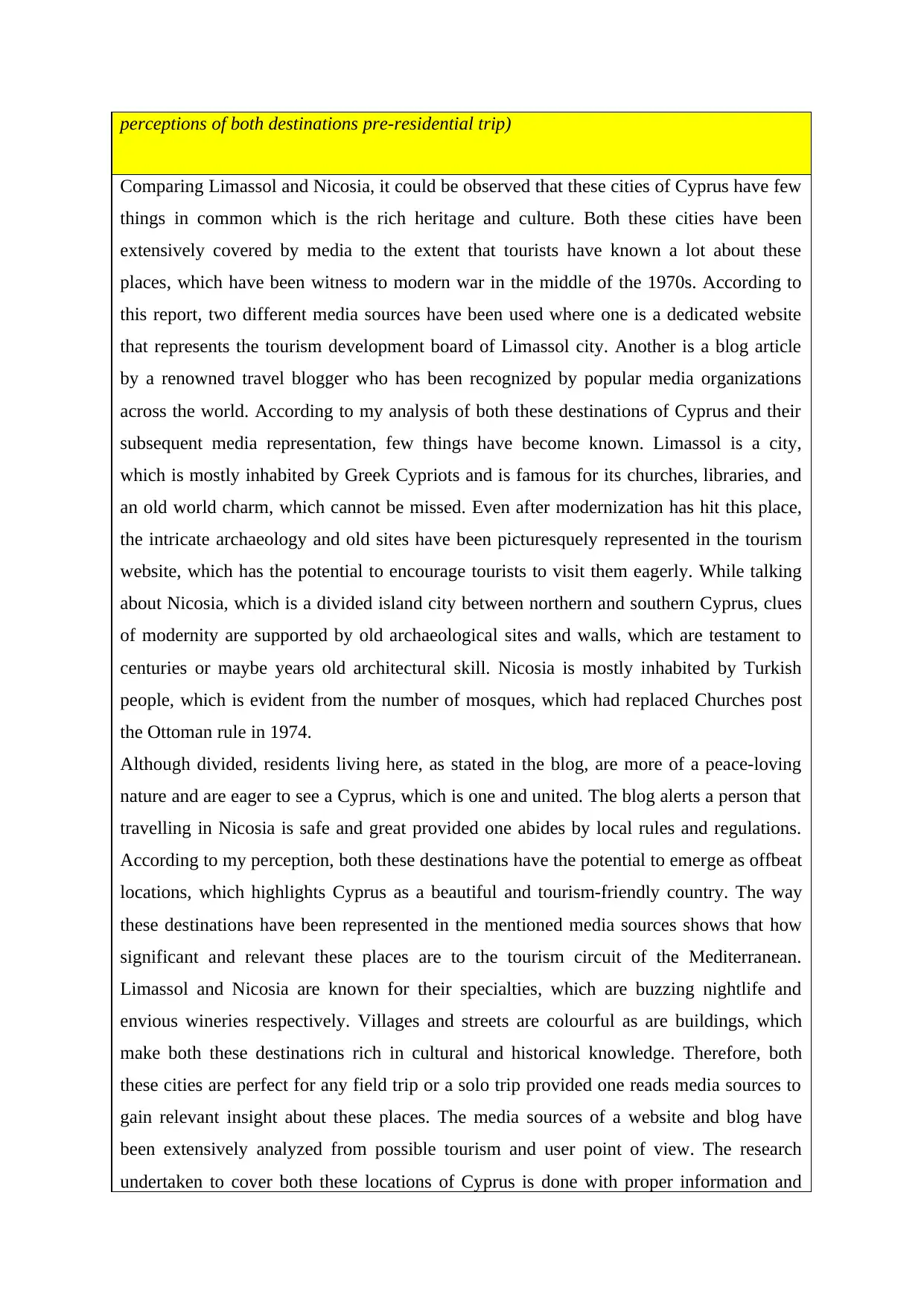
perceptions of both destinations pre-residential trip)
Comparing Limassol and Nicosia, it could be observed that these cities of Cyprus have few
things in common which is the rich heritage and culture. Both these cities have been
extensively covered by media to the extent that tourists have known a lot about these
places, which have been witness to modern war in the middle of the 1970s. According to
this report, two different media sources have been used where one is a dedicated website
that represents the tourism development board of Limassol city. Another is a blog article
by a renowned travel blogger who has been recognized by popular media organizations
across the world. According to my analysis of both these destinations of Cyprus and their
subsequent media representation, few things have become known. Limassol is a city,
which is mostly inhabited by Greek Cypriots and is famous for its churches, libraries, and
an old world charm, which cannot be missed. Even after modernization has hit this place,
the intricate archaeology and old sites have been picturesquely represented in the tourism
website, which has the potential to encourage tourists to visit them eagerly. While talking
about Nicosia, which is a divided island city between northern and southern Cyprus, clues
of modernity are supported by old archaeological sites and walls, which are testament to
centuries or maybe years old architectural skill. Nicosia is mostly inhabited by Turkish
people, which is evident from the number of mosques, which had replaced Churches post
the Ottoman rule in 1974.
Although divided, residents living here, as stated in the blog, are more of a peace-loving
nature and are eager to see a Cyprus, which is one and united. The blog alerts a person that
travelling in Nicosia is safe and great provided one abides by local rules and regulations.
According to my perception, both these destinations have the potential to emerge as offbeat
locations, which highlights Cyprus as a beautiful and tourism-friendly country. The way
these destinations have been represented in the mentioned media sources shows that how
significant and relevant these places are to the tourism circuit of the Mediterranean.
Limassol and Nicosia are known for their specialties, which are buzzing nightlife and
envious wineries respectively. Villages and streets are colourful as are buildings, which
make both these destinations rich in cultural and historical knowledge. Therefore, both
these cities are perfect for any field trip or a solo trip provided one reads media sources to
gain relevant insight about these places. The media sources of a website and blog have
been extensively analyzed from possible tourism and user point of view. The research
undertaken to cover both these locations of Cyprus is done with proper information and
Comparing Limassol and Nicosia, it could be observed that these cities of Cyprus have few
things in common which is the rich heritage and culture. Both these cities have been
extensively covered by media to the extent that tourists have known a lot about these
places, which have been witness to modern war in the middle of the 1970s. According to
this report, two different media sources have been used where one is a dedicated website
that represents the tourism development board of Limassol city. Another is a blog article
by a renowned travel blogger who has been recognized by popular media organizations
across the world. According to my analysis of both these destinations of Cyprus and their
subsequent media representation, few things have become known. Limassol is a city,
which is mostly inhabited by Greek Cypriots and is famous for its churches, libraries, and
an old world charm, which cannot be missed. Even after modernization has hit this place,
the intricate archaeology and old sites have been picturesquely represented in the tourism
website, which has the potential to encourage tourists to visit them eagerly. While talking
about Nicosia, which is a divided island city between northern and southern Cyprus, clues
of modernity are supported by old archaeological sites and walls, which are testament to
centuries or maybe years old architectural skill. Nicosia is mostly inhabited by Turkish
people, which is evident from the number of mosques, which had replaced Churches post
the Ottoman rule in 1974.
Although divided, residents living here, as stated in the blog, are more of a peace-loving
nature and are eager to see a Cyprus, which is one and united. The blog alerts a person that
travelling in Nicosia is safe and great provided one abides by local rules and regulations.
According to my perception, both these destinations have the potential to emerge as offbeat
locations, which highlights Cyprus as a beautiful and tourism-friendly country. The way
these destinations have been represented in the mentioned media sources shows that how
significant and relevant these places are to the tourism circuit of the Mediterranean.
Limassol and Nicosia are known for their specialties, which are buzzing nightlife and
envious wineries respectively. Villages and streets are colourful as are buildings, which
make both these destinations rich in cultural and historical knowledge. Therefore, both
these cities are perfect for any field trip or a solo trip provided one reads media sources to
gain relevant insight about these places. The media sources of a website and blog have
been extensively analyzed from possible tourism and user point of view. The research
undertaken to cover both these locations of Cyprus is done with proper information and
Paraphrase This Document
Need a fresh take? Get an instant paraphrase of this document with our AI Paraphraser
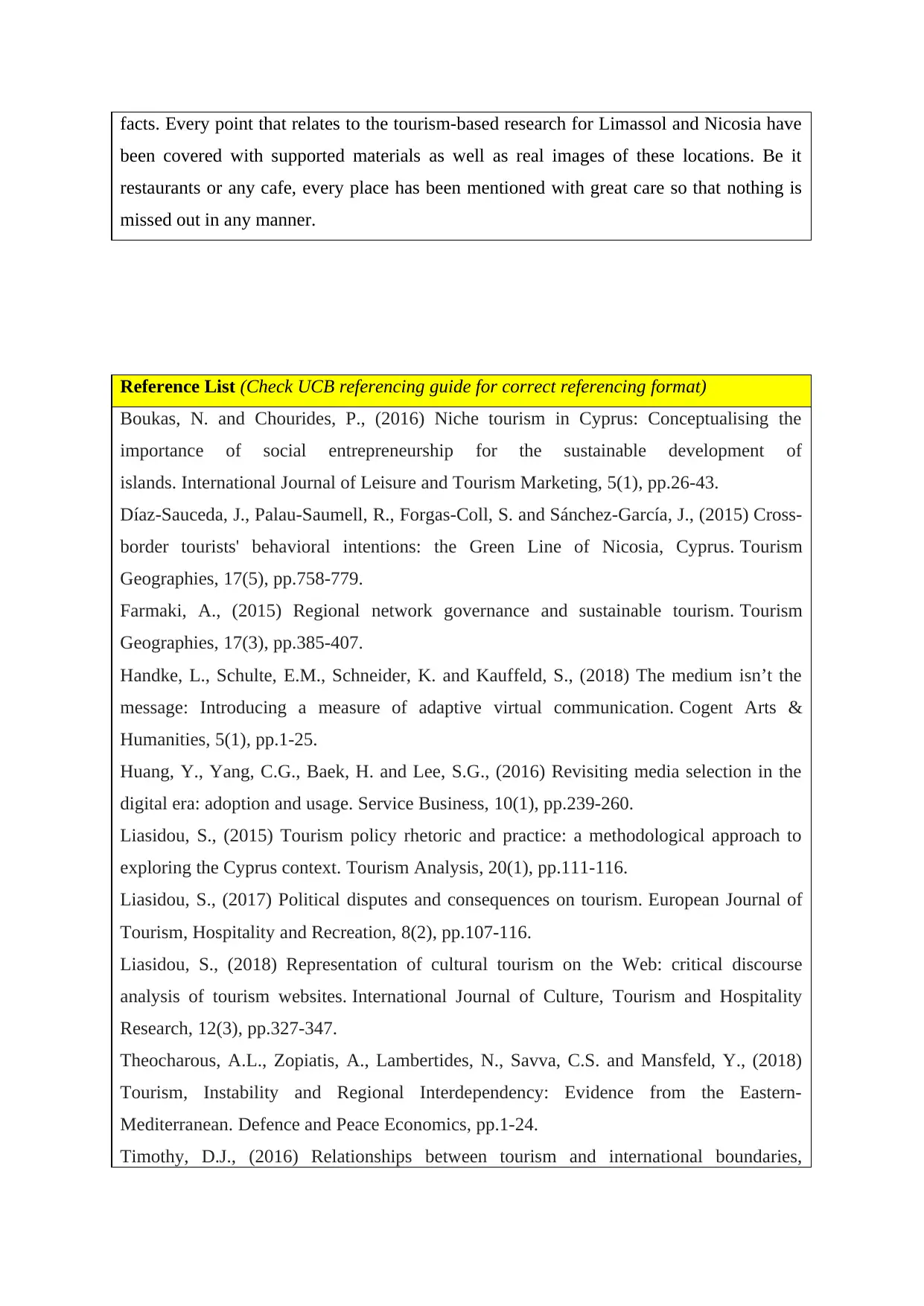
facts. Every point that relates to the tourism-based research for Limassol and Nicosia have
been covered with supported materials as well as real images of these locations. Be it
restaurants or any cafe, every place has been mentioned with great care so that nothing is
missed out in any manner.
Reference List (Check UCB referencing guide for correct referencing format)
Boukas, N. and Chourides, P., (2016) Niche tourism in Cyprus: Conceptualising the
importance of social entrepreneurship for the sustainable development of
islands. International Journal of Leisure and Tourism Marketing, 5(1), pp.26-43.
Díaz-Sauceda, J., Palau-Saumell, R., Forgas-Coll, S. and Sánchez-García, J., (2015) Cross-
border tourists' behavioral intentions: the Green Line of Nicosia, Cyprus. Tourism
Geographies, 17(5), pp.758-779.
Farmaki, A., (2015) Regional network governance and sustainable tourism. Tourism
Geographies, 17(3), pp.385-407.
Handke, L., Schulte, E.M., Schneider, K. and Kauffeld, S., (2018) The medium isn’t the
message: Introducing a measure of adaptive virtual communication. Cogent Arts &
Humanities, 5(1), pp.1-25.
Huang, Y., Yang, C.G., Baek, H. and Lee, S.G., (2016) Revisiting media selection in the
digital era: adoption and usage. Service Business, 10(1), pp.239-260.
Liasidou, S., (2015) Tourism policy rhetoric and practice: a methodological approach to
exploring the Cyprus context. Tourism Analysis, 20(1), pp.111-116.
Liasidou, S., (2017) Political disputes and consequences on tourism. European Journal of
Tourism, Hospitality and Recreation, 8(2), pp.107-116.
Liasidou, S., (2018) Representation of cultural tourism on the Web: critical discourse
analysis of tourism websites. International Journal of Culture, Tourism and Hospitality
Research, 12(3), pp.327-347.
Theocharous, A.L., Zopiatis, A., Lambertides, N., Savva, C.S. and Mansfeld, Y., (2018)
Tourism, Instability and Regional Interdependency: Evidence from the Eastern-
Mediterranean. Defence and Peace Economics, pp.1-24.
Timothy, D.J., (2016) Relationships between tourism and international boundaries,
been covered with supported materials as well as real images of these locations. Be it
restaurants or any cafe, every place has been mentioned with great care so that nothing is
missed out in any manner.
Reference List (Check UCB referencing guide for correct referencing format)
Boukas, N. and Chourides, P., (2016) Niche tourism in Cyprus: Conceptualising the
importance of social entrepreneurship for the sustainable development of
islands. International Journal of Leisure and Tourism Marketing, 5(1), pp.26-43.
Díaz-Sauceda, J., Palau-Saumell, R., Forgas-Coll, S. and Sánchez-García, J., (2015) Cross-
border tourists' behavioral intentions: the Green Line of Nicosia, Cyprus. Tourism
Geographies, 17(5), pp.758-779.
Farmaki, A., (2015) Regional network governance and sustainable tourism. Tourism
Geographies, 17(3), pp.385-407.
Handke, L., Schulte, E.M., Schneider, K. and Kauffeld, S., (2018) The medium isn’t the
message: Introducing a measure of adaptive virtual communication. Cogent Arts &
Humanities, 5(1), pp.1-25.
Huang, Y., Yang, C.G., Baek, H. and Lee, S.G., (2016) Revisiting media selection in the
digital era: adoption and usage. Service Business, 10(1), pp.239-260.
Liasidou, S., (2015) Tourism policy rhetoric and practice: a methodological approach to
exploring the Cyprus context. Tourism Analysis, 20(1), pp.111-116.
Liasidou, S., (2017) Political disputes and consequences on tourism. European Journal of
Tourism, Hospitality and Recreation, 8(2), pp.107-116.
Liasidou, S., (2018) Representation of cultural tourism on the Web: critical discourse
analysis of tourism websites. International Journal of Culture, Tourism and Hospitality
Research, 12(3), pp.327-347.
Theocharous, A.L., Zopiatis, A., Lambertides, N., Savva, C.S. and Mansfeld, Y., (2018)
Tourism, Instability and Regional Interdependency: Evidence from the Eastern-
Mediterranean. Defence and Peace Economics, pp.1-24.
Timothy, D.J., (2016) Relationships between tourism and international boundaries,
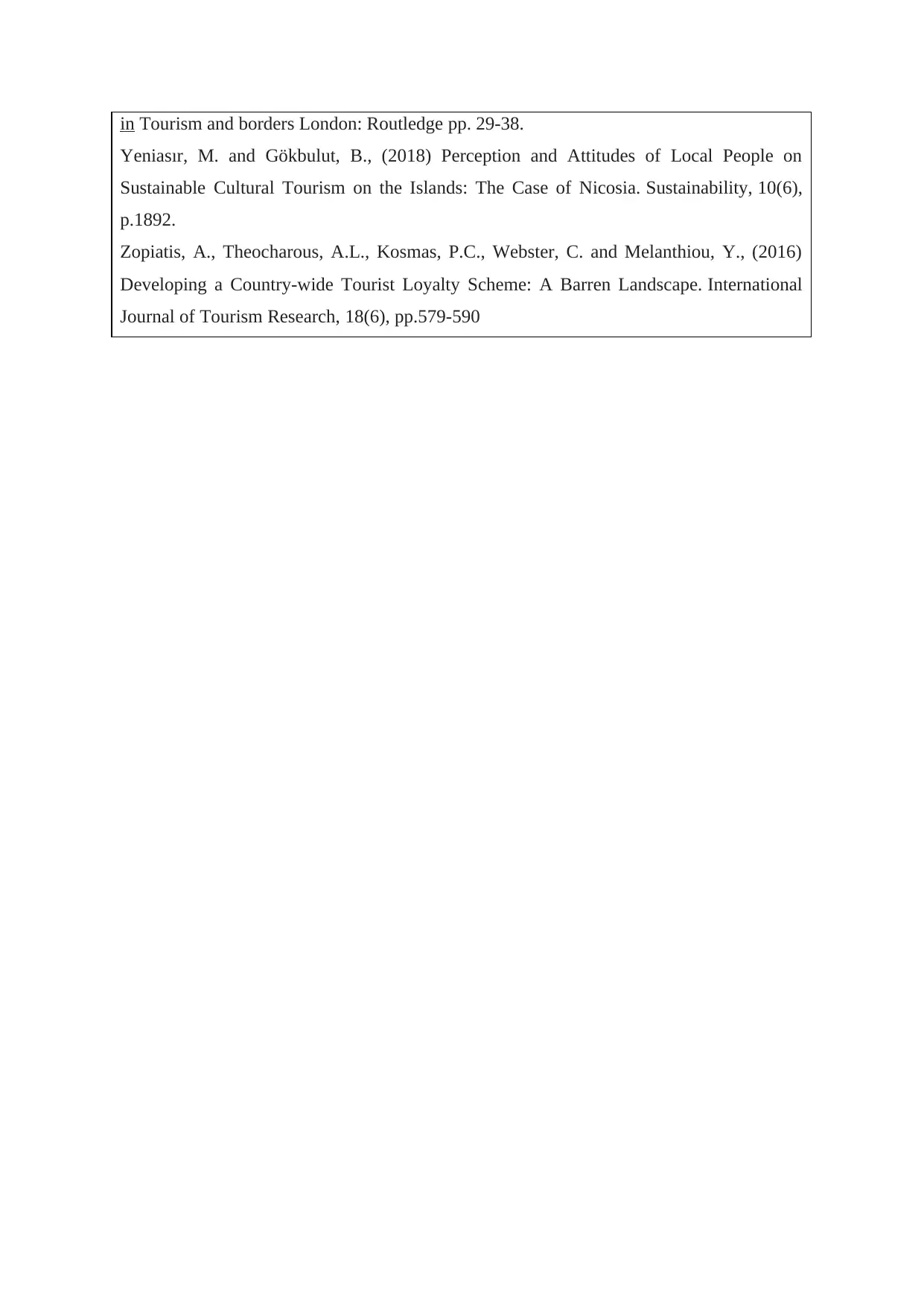
in Tourism and borders London: Routledge pp. 29-38.
Yeniasır, M. and Gökbulut, B., (2018) Perception and Attitudes of Local People on
Sustainable Cultural Tourism on the Islands: The Case of Nicosia. Sustainability, 10(6),
p.1892.
Zopiatis, A., Theocharous, A.L., Kosmas, P.C., Webster, C. and Melanthiou, Y., (2016)
Developing a Country‐wide Tourist Loyalty Scheme: A Barren Landscape. International
Journal of Tourism Research, 18(6), pp.579-590
Yeniasır, M. and Gökbulut, B., (2018) Perception and Attitudes of Local People on
Sustainable Cultural Tourism on the Islands: The Case of Nicosia. Sustainability, 10(6),
p.1892.
Zopiatis, A., Theocharous, A.L., Kosmas, P.C., Webster, C. and Melanthiou, Y., (2016)
Developing a Country‐wide Tourist Loyalty Scheme: A Barren Landscape. International
Journal of Tourism Research, 18(6), pp.579-590
⊘ This is a preview!⊘
Do you want full access?
Subscribe today to unlock all pages.

Trusted by 1+ million students worldwide
1 out of 9
Your All-in-One AI-Powered Toolkit for Academic Success.
+13062052269
info@desklib.com
Available 24*7 on WhatsApp / Email
![[object Object]](/_next/static/media/star-bottom.7253800d.svg)
Unlock your academic potential
Copyright © 2020–2025 A2Z Services. All Rights Reserved. Developed and managed by ZUCOL.